Osteoporosis is a disease that causes the bones to become weak and brittle, often as a result of a change in hormones or deficiency of calcium or vitamin D. Women are at a much higher risk for osteoporosis than men. Why is this and what can women do to reduce their risk?
Facts about Women and Osteoporosis
- An estimated 10 million Americans have osteoporosis, and about 80 percent of them are women.
- About one in two women over age 50 will break a bone due to osteoporosis.
- A woman’s risk of breaking her hip is equal to her combined risk of breast, uterine and ovarian cancer.
Women have smaller, thinner bones than men, which is a major factor behind the large gap in males and females with osteoporosis. Estrogen also decreases as women get older and reach menopause—because estrogen helps protect bones, this development can increase the risk of osteoporosis as women reach this stage in life.
Risk Groups
A woman’s risk of osteoporosis and other bone issues vary between different ages and ethnic backgrounds. Here’s a look at a few specific risk groups:
- Caucasian women: Caucasian women are most at risk for osteoporosis, along with older women. Twenty percent of Caucasian women over 50 are estimated to have osteoporosis. Caucasian women lose a third of their bone mineral density in their hip between ages 20 and 80, and over half of all Caucasian women over 50 have low bone mass, which can lead to osteoporosis.
- African-American women: About five percent of African-American women over 50 are estimated to have osteoporosis. Additionally, around 70 percent of African-American women are lactose intolerant, which can make calcium intake difficult. Even among African-American women at higher risk, few are screened for osteoporosis.
- Asian-American women: Asian-American women over 50 have osteoporosis about 20 percent of the time, and about 90 percent are lactose intolerant. More than 50 percent have low bone density.
- • Latina women: Ten percent of Latinas have osteoporosis, and hip fractures among Latinas in the United States appear to be on the rise. About half of Latinas over 50 have bone density issues and many are lactose intolerant.
How Menopause Affects Osteoporosis
Menopause is a period of life where estrogen levels drop and bone loss can increase rapidly. Two factors that are vital during this period include:
- How much bone you have when you reach menopause: The greater bone density is at this time, the lower your chance of developing osteoporosis.
- How fast you lose bone after menopause: Not all women lose bone at the same rate after menopause. Some women can lose up to 20 percent of their bone density during the five to seven years directly following menopause. The higher the rate of loss, the greater the chances of osteoporosis.
Preventing Osteoporosis
Both in your earlier years and leading up toward menopause, there are steps you can take to improve bone density and reduce your chances of developing osteoporosis. Here are a few:
- Get enough protein: Protein is vital for bones, and not everyone gets enough in their diet. If you’re a vegetarian or vegan, eat foods like soy, nuts, legumes and dairy or eggs (if allowed). If needed, you may want to try protein supplementation.
- • Maintain a healthy weight: Excess weight increases your risk of fracture in the arm and wrist, and maintaining healthy weight is important for good bones.
- Manage your calcium intake: Between the ages of 18 and 50, men and women need 1,000 milligrams of calcium a day. When women reach 50 and when men reach 70, this increases to 1,200 milligrams a day. Good sources of calcium include low-fat dairy, dark leafy greens, canned salmon or sardines with bones, soy products and calcium-fortified cereals or orange juice. Calcium supplements can also be a consideration, though too much calcium in supplements can lead to kidney stones or heart disease, so be careful here. Calcium intake should not exceed 2,000 milligrams for people over 50.
- Get more vitamin D: Vitamin D improves the body’s ability to absorb calcium and helps improve bone health. Scientists don’t yet know the optimal daily dose for vitamin D, but a good starting point is between 600 and 800 international units per day. Sunlight is a primary source of vitamin D, but some people may need more, such as supplements.
- • Exercise regularly: Exercise builds strong bones and prevents bone loss, and will show the most benefits if it begins early in life. Combine strength training with weight-bearing and balance exercises.
- • Avoid smoking and alcohol: Both substances can have a negative effect on bone mass, so limit your use or eliminate it altogether.
If you’re worried about your risk for osteoporosis and approaching menopause, your doctor can give you further recommendations for maintaining healthy bones.
Our Utah County Endocrinologist is able to help diagnose and treat endocrine system disorders—even complex cases in which conventional treatments don’t work. As trained specialists, our providers know the latest treatments and technologies to treat a variety of disorders.
Sources:
“What Women Need to Know.” National Osteoporosis Foundation. https://www.nof.org/preventing-fractures/general-facts/what-women-need-to-know/
“Osteoporosis (Self-management).” The Mayo Clinic. http://www.mayoclinic.org/diseases-conditions/osteoporosis/manage/ptc-20207963





